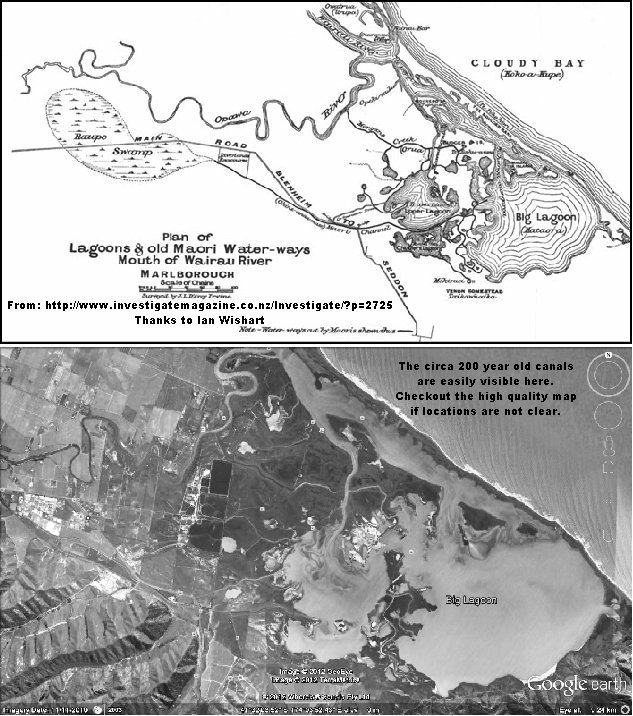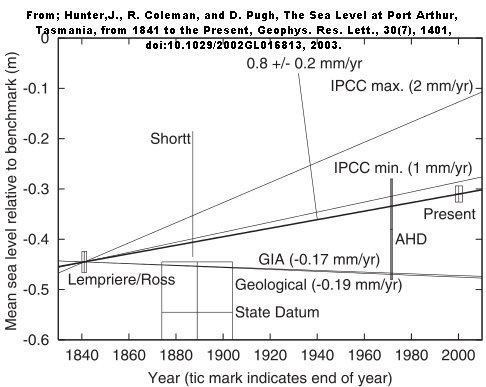Thanks to Graeme Inkster for bringing this to my attention from the Investigate Magazine of Ian Wishart.

I found the 1912 source paper online – thanks to the The Journal of The Polynesian Society. The 1912 paper “ANCIENT MAORI CANALS. MARLBOROUGH, N.Z.” by W. H. Skinner – states – “These Canals or channels are a unique feature in the topography of the ‘Mud Flats’ near the mouth of the Wairau River, and are about six miles from Blenheim, and average about two miles from the seashore. The Canals are evidently the work of numerous bands of Maoris, who must have toiled for years in the excavation of the various waterways, as they are of an aggregate length exceeding twelve miles.” For higher quality map.
The paper say the canals were complete 100 to 120 years ago which was circa 1800 – so we are talking about sea level being essentially stable over 200 years.
We must not forget that at least two geological factors could be contributing to the relative level of sea and land here.
Land movements due tectonics and cumulative seismic activity might be raising the land.
Any locality at a river mouth where deposition of river sediments has been progressively loading the crust and the new sediments compacting – so must be sinking – with the level of the land being made up by continued deposition of river flat sediments. Eventually natural processes must fill in these canals – but it is fascinating they still exist and I look forward to hearing an expert assessment.
This map shows the active Alpine Fault and related faults as they pass through Blenheim – and note the cliffs bounding the south side of the coastal lagoons in this tourist photo probably mark the line of a fault scarp which would be a splay off the Awatere Fault.
New Zealand’s Southern Alps are one of the fastest-rising mountain ranges in the world, and over the last 5 million years they have been moving up at an average rate of about a centimetre per year. This uplift is not continuous – much of it occurs in jumps of several metres at a time during earthquakes along the Alpine Fault.
Let us not forget the Late and Great John Daly – see his article on sea level at Port Arthur, Tasmania where an 1841 sea level benchmark is still well above low tide. Tasmania is relatively stable tectonically compared to New Zealand.
Warwick, re Port Arthur there are two papers about that Pugh, Hunter Coleman & Watson in IHR Nov 2002 and Hunter, Coleman & Pugh GRL vol30 No7 2003. I did not record my source of the PDF of the first one but the second was sent to me by Dr Hunter. Basically, they found that there has been some geological uplift of 0.2mm+/-0.02 per yr and including this they find from 1841 to 2002 a sea level rise of 0.8mm +/-0.2mm per yr which is considerably lower that the lowest levels of IPCC estimates. You may know that The Aust. Baseline Sea Level Monitoring Project finds negative sea level rises in Bass Strait over 60 years (eg Burnie) probably due to rise in land levels.
Found the link for the first paper eprints.utas.edu.au/6994/2/NewPugh_et_al_IHR_2002.pdf -hope it works. Beside Burnie, Point Lonsdale (With over 40 yrs of data) on the Victorian side has negative sea level rise which was -1.57mm/yr to 2003. For Hobart the official figure (BOM National Tidal centre) for the 35yrs to 2003 was 0.91mm/yr. You maybe interested that the Geraldton WA figure for the 38yrs to 2003 was 0.46mm/yr. Of course that is not the spin the top brass at BOM want to put.
Gidday cementafriend – I found a pdf copy of Hunter 2003 buried deep on a HDD –

Citation: Hunter,J., R. Coleman, and D. Pugh, The Sea Level at Port Arthur, Tasmania, from 1841 to the Present, Geophys. Res. Lett., 30(7), 1401,
doi:10.1029/2002GL016813, 2003. here is their summary diagram. Your link for the 2002 paper took me to a UTAS login wall.
They concluded – “…an average rate of sea level rise, relative to the
land, of 0.8 ± 0.2 mm/year over the period 1841 to 2002. When combined with estimates of land uplift, this yields an estimate of average sea level rise due to an increase in the volume of the oceans of 1.0 ± 0.3 mm/year, over the same
period. These results are at the lower end of the recent estimate by the Intergovernmental Panel on Climate Change of global average rise for the 20th century.”
Yes a Biblical 12.8cm over 160 years or 16cm if you allow for land rising.
I didn’t see any mention of the impact of changes in the volume of the ocean basins as a result of the horizontal components of tectonic activity. When we are considering the recent small variations in sea level, compared to the variations that have occurred on a geological time scale, then surely changes in basin volume could be an important contributing factor?
From an article from University of Puerto Rico, it includes the obligatory forelock tug to the CO2 orthodoxy but apart from that it seems to be an objective treatment of the subject of sea level change:
Also Making it up (1) and (2) recent relevant posts by MostlyHarmless:
mostlyharmless-room-101.blogspot.com.au/2012/04/making-it-up-1-study-finds-greenlands.html
mostlyharmless-room-101.blogspot.com.au/2012/04/making-it-up-2-sea-level-rising-fastest.html